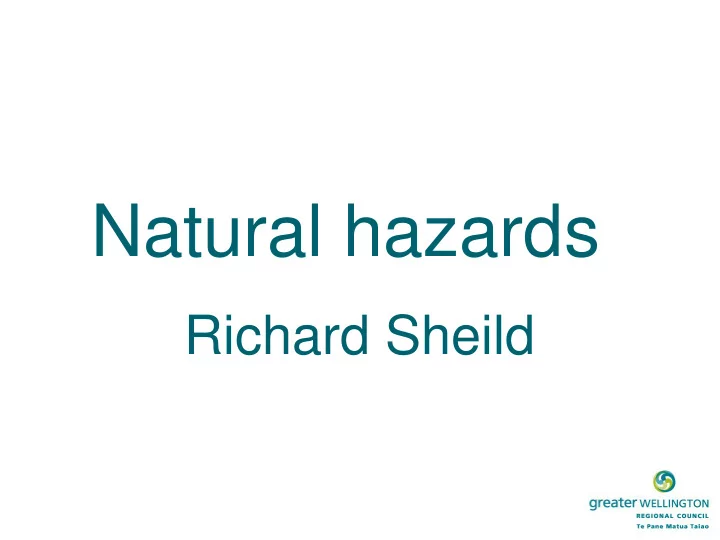

Natural hazards Richard Sheild
Provisions in this presentation • Definitions of risk, risk-based approach, residual risk, hard engineering, soft engineering, high hazard areas, and hazard management strategy. • Objectives O20, O21, and O22 • Policies P27, P28, P29, and P30 • Methods M3 and M4
Presentation Outline • Statutory framework • PNRP hazards framework • Key issues from submissions • Recommendations • Areas of contention
Resource Management Act • Section 6(a): GWRC must recognise and provide for the preservation of the natural character of the coastal environment, wetlands, lakes and rivers. • Section 7(i): GWRC must have particular regard for the effects of climate change.
Resource Management Act • Section 30(1)(c)(iv): Control the use of land for the purpose of avoiding or mitigating natural hazards. • Section 30(1)(d)(v): In respect of the CMA, control any actual or potential effects of the use, development, or protection of land, including the avoidance or mitigation of natural hazards.
New Zealand Coastal Policy Statement • Objective 5 – Management of coastal hazard risk. • Policy 24 – Identification of coastal hazards. • Policy 25 – Use and development in areas of coastal hazard risk. • Policy 26 – Natural defences against coastal hazards. • Policy 27 – Protecting significant existing development from coastal hazard risk.
Regional Policy Statement • Objective 19 – Risk and consequences of natural hazard are reduced. • Objective 20 – Hazard mitigation measures do not increase hazard risk. • Objective 21 – Communities are more resilient to natural hazards.
Regional Policy Statement • Policy 29 – Identify areas at high risk and avoid inappropriate development and subdivision. • Policy 51 – Minimise risk and consequences of natural hazards. • Policy 52 – Give particular regard to need for hard engineering, and whether soft engineering is more appropriate.
Definitions • Risk • Risk-based approach • Residual risk • High hazard areas • Hard engineering • Hazard management strategy • Soft engineering
Objectives • Objective O20 – The risk, residual risk, and adverse effects from natural hazards and climate change are acceptable. • Objective O21 – Inappropriate use and development in high hazard areas is avoided. • Objective O22 – Hard engineering mitigation and protection methods are only used as a last practicable option.
Policies • Policy P27 – sets direction around use and development in high hazard areas. • Policy P28 – sets direction around hard engineering and when such methods can be used. • Policy P29 – articulates when effects of climate change should be considered. • Policy P30 – sets direction on effects of use and development on natural buffers.
Methods • Method M3 – GWRC will work with TA’s and other stakeholders to develop and implement a Wellington regional hazard management strategy. • Method M4 – GWRC will develop regional guidance for managing impacts from sea- level rise.
The risk-based approach • Clarifying what is considered appropriate risk. • Use of the risk-based approach in consenting.
Use of “high hazard areas” • Rationale behind high hazard areas definition and designation. • Possible exemptions to avoiding use and development.
Hard engineering vs. soft engineering • Clarify in which circumstances hard engineering can be used. • Make hard engineering structures be easier to gain consent for.
Climate change • Add definition for climate change. • Ensure climate change provisions give effect to the NZCPS. • Consider climate change in a wider context.
Policy P27: High hazard areas • Refer to “acceptable” rather than “low” risk in (b). • Refer to “adverse effects” rather than “interference”. • Replace “fluvial and lacustrine” with “river and lake” in (d). • Add reference to “over at least the next 100 years” in clause (e).
Policy P28: Hazard mitigation measures • Split P28 into clauses (a) and (b). • Add reference to functional need or operational requirement. • Refer to a “risk management strategy” rather than a “hazard management strategy”.
Policy P29: Climate change • Rename P29 “Effects of climate change”. • Add reference to impacts on biodiversity, aquatic ecosystem health, mahinga kai, and to “over at least the next 100 years” to the preamble. • Add reference to “decreased minimum flows” to (b). • Refer to “relative sea level rise” in (d).
Policy P30: Natural buffers • Refer to “natural wetlands” rather than “wetlands”. • Add reference to providing for “ the restoration and enhancement of natural buffers”.
Method M4: Sea level rise • Correct reference to “Intergovernmental Panel on Climate Change”.
Definition of “hazard management strategy” • Change definition to “risk management strategy”, and replace references to “hazard” with “risk”. • Add reference to the scale of a strategy being aligned with the scale of the activity.
Matters still in contention • High hazard areas: O21 and P27. • Hard engineering: O22 and P28.
Recommend
More recommend